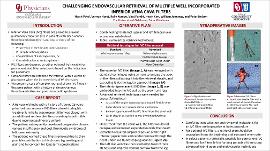| dc.description.abstract | INTRODUCTION: Inferior Vena Cava (IVC) filters are placed in patients to prevent pulmonary embolism in patients with recurrent deep venous thromboembolism or in high risk patients who cannot tolerate anticoagulation at their initial event. IVC filters are designed as either optional (retrievable) or permanent, and filter selection is based on the indication for placement. We present a case of complex retrieval of two IVC filters from the same patient with a history of chronic venous thromboembolism and post thrombotic syndrome.
CASE DESCRIPTION: Our patient is a 63 year-old male with a remote history of trauma that resulted in chronic venous thromboembolism and post thrombotic syndrome of left lower extremity. He presents a rare case where he had two separate IVC filters placed during his treatment; initially, a permanent filter was placed, with an additional retrievable filter placed due to recurrent pulmonary emboli. He eventually tolerated anticoagulation, and wanted these filters removed due to their possible contribution to his chronic leg swelling and pain.
From a right internal jugular vein approach, the retrievable superior filter was removed with the conventional snaring technique. We were unable to remove the second filter using conventional snare technique, as well as a through and through “flossing” approach from both jugular and femoral vein access points. We then proceeded with using a 16Fr laser extractor sheath with multiple laser treatments, followed by large aortic balloon expansion from the femoral access site, in an attempt to loosen the filter from the IVC sidewall. This combination of approaches did free the filter from the IVC wall, but the filter remained outside the sheath. Under fluoroscopic visualization, we brought the dislodged filter into the internal jugular vein and, after surgically exposing the vein, successfully removed the filter. Completion venogram confirmed removal of both filters without venous extravasation.
DISCUSSION: This case illustrates the complexity in removing permanent IVC filters in select patients wherein the legs of the filter have embedded into the IVC wall. In patients with higher complexity of IVC filter removal, various methods have been described. Two advanced modes of extraction which are popular are the Endobronchial Forceps Extractions and the Laser-Assist Snare Extraction. Different devices have their unique characteristics and different failure modes. In patients with filter legs embedded in the vessel wall, a more robust approach with laser-assist, balloon endotraction, and external traction to free it from the IVC sidewall may be required for successful retrieval, as in this patient. | en_US |

